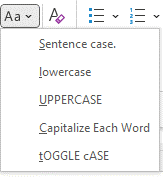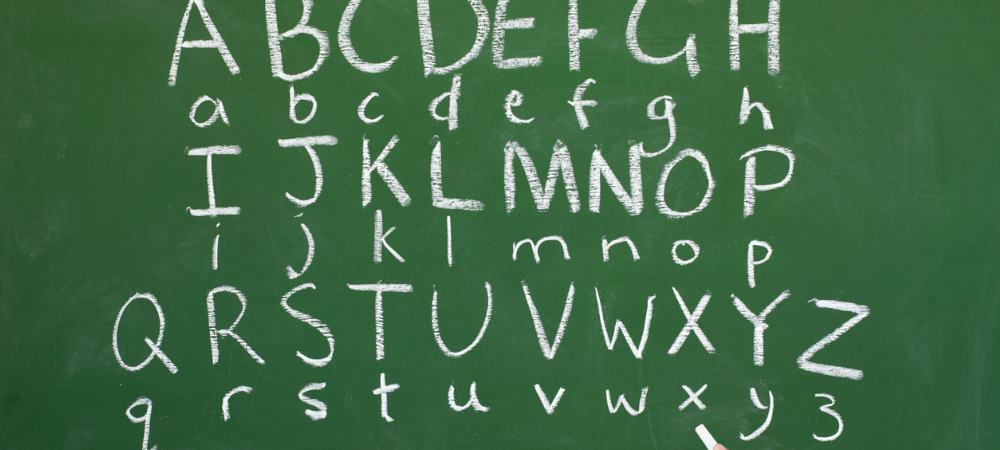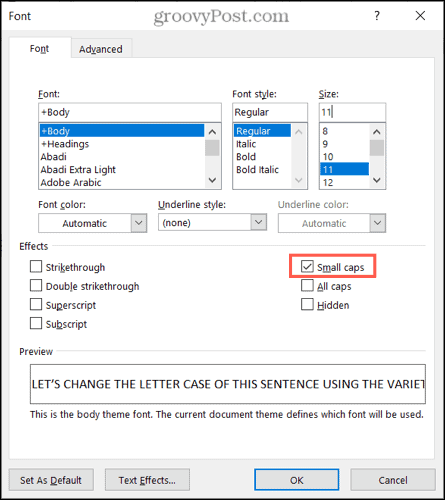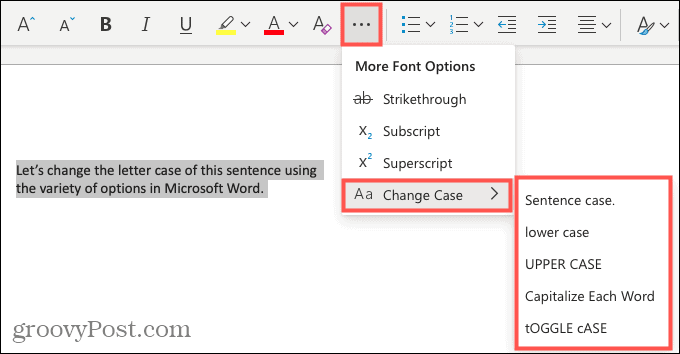You can change the capitalization, or case, of selected text in a document by clicking a single button on the Home tab called Change Case.
Change case
To change the case of selected text in a document, do the following:
-
Select the text for which you want to change the case.
-
Go to Home > Change case
.
-
Do one of the following:
-
To capitalize the first letter of a sentence and leave all other letters as lowercase, click Sentence case.
-
To exclude capital letters from your text, click lowercase.
-
To capitalize all of the letters, click UPPERCASE.
-
To capitalize the first letter of each word and leave the other letters lowercase, click Capitalize Each Word.
-
To shift between two case views (for example, to shift between Capitalize Each Word and the opposite, cAPITALIZE eACH wORD), click tOGGLE cASE.
Tips:
-
To apply small capital (Small Caps) to your text, select the text, and then on the Home tab, in the Font group, click the arrow in the lower-right corner. In the Font dialog box, under Effects, select the Small Caps check box.
-
To undo the case change, press CTRL+ Z.
-
To use a keyboard shortcut to change between lowercase, UPPERCASE, and Capitalize Each Word, select the text and press SHIFT + F3 until the case you want is applied.
-
See also
Insert a drop cap
Choose AutoCorrect options for capitalization
Change case
To change the case of selected text in a document, do the following:
-
Select the text for which you want to change the case.
-
Go to Home > Change case
.
-
Do one of the following:
-
To capitalize the first letter of a sentence and leave all other letters as lowercase, click Sentence case.
-
To exclude capital letters from your text, click lowercase.
-
To capitalize all of the letters, click UPPERCASE.
-
To capitalize the first letter of each word and leave the other letters lowercase, click Capitalize Each Word.
-
To shift between two case views (for example, to shift between Capitalize Each Word and the opposite, cAPITALIZE eACH wORD), click tOGGLE cASE.
Tips:
-
To apply small capital (Small Caps) to your text, select the text, and then on the Format menu, select Font, and in the Font dialog box, under Effects, select the Small Caps box.
Small Caps shortcut key: ⌘ + SHIFT + K
-
To undo the case change, press ⌘ + Z .
-
To use a keyboard shortcut to change between lowercase, UPPERCASE, and Capitalize Each Word, select the text and then press fn+ SHIFT + F3 until the style you want is applied.
-
See also
Insert a drop cap
Choose AutoCorrect options for capitalization
PowerPoint for the web supports changing case. See the procedure below.
Word for the web doesn’t support changing case. Use the desktop application to open the document and change text case there, or else you can manually change the casing of text in Word for the web.
-
Select the text you want to change.
-
Go to Home > More Font Options > Change case.
-
Choose the case you want to use.
Updated: 12/30/2021 by
In Microsoft Word, you can use the keyboard shortcut Shift+F3 to change selected text between uppercase, lowercase, and title case.
Selecting a case
- Highlight all the text you want to change. If you want to change the case for the whole document you can use the Ctrl+A keyboard shortcut to select everything.
- Hold down Shift and press F3.
- When you hold Shift and press F3, the text toggles from sentence case (first letter uppercase and the rest lowercase), to all uppercase (all capital letters), and then all lowercase.
Note
If you are using a laptop or an Apple Mac, the function keys may not be enabled without the use of the Fn key. You may need to hold Fn, in addition to Shift, when you press F3.
If you’re not able to get Shift+F3 to work in Microsoft Word 2007 or later, you can try the following option instead.
- In the menu bar, on the Home tab, click the Change Case icon, which has an uppercase ‘A’ and lowercase ‘a.’
- Select the appropriate option from the list of values. For example, if you want to change to all uppercase letters, select the UPPERCASE option. If you want to change to all lowercase letters, select the lowercase option.
Tip
Use our text tool to convert any text from uppercase to lowercase.
3 Ways to Change or Convert Case in Microsoft Word Documents (with Shortcuts)
by Avantix Learning Team | Updated August 1, 2022
Applies to: Microsoft® Word® 2013, 2016, 2019, 2021 or 365 (Windows)
You can change case in Microsoft Word documents by changing character formatting or by converting case. If you want to be able to easily change case (like removing All Caps), it’s best to change case by applying formatting such as All Caps or Small Caps. Alternatively, you use the Change Case command to convert case. This command offers a series of options including upper, lower, capitalize each word and sentence case. You can also use a keyboard shortcut to move through different case options.
Recommended article: How to Create a Table of Contents in Word
Do you want to learn more about Microsoft Word? Check out our virtual classroom or in-person classroom Word courses >
Change Case using the Font dialog box (apply or remove All Caps or Small Caps)
To apply All Caps or Small Caps to text as a format using the Font dialog box:
- Select the text.
- Click the Home tab in the Ribbon.
- Click the dialog box launcher on the bottom right of the Font group. Alternatively, press Ctrl + D. The Font dialog box appears.
- Select All Caps or Small Caps.
- Click OK.
The Font dialog box appears as follows:
This is usually the best way to apply All Caps since it’s a format and can be removed using the Font dialog box. You can also build this format into styles.
Change case using the Change Case command in the Ribbon
If text has been formatted with hard capitals where the user has pressed the Caps Lock key when typing text, you can remove or change the capitalization using the Change Case command. You can convert a selection typed in upper case to title case, lower case or even sentence case.
To change case using the Change Case command in the Ribbon:
- Select the text.
- Click the Home tab in the Ribbon.
- Click Change Case in the Font group (Aa). A drop-down menu appears.
- Select the desired case.
The Change Case drop-down menu appears as follows:
The following options appear in the Change Case drop-down menu:
- Sentence case – capitalizes the first letter of a sentence. If there are multiple sentences, Word will capitalize the next word after a period.
- Lowercase – removes all capitalization.
- UPPERCASE – capitalizes all letters in the selection.
- Capitalize Each Word – capitalizes each word in the selection (often called title case).
- tOGGLE cASE – shifts between two cases. For example, if the first letter of each word in the selection was capitalized, this command would switch to the opposite formatting with the first letter of each word as lower case and the other letters in upper case.
Change case using keyboard shortcuts
You can use keyboard shortcuts to move between several of the options in the Change Case drop-down menu:
- Select the text.
- Press Shift + F3. Keep pressing Shift + F3 to move between UPPERCASE, lowercase and Capitalize Each Word.
Some users may need to press the Fn key as well to activate the F3 key.
Subscribe to get more articles like this one
Did you find this article helpful? If you would like to receive new articles, JOIN our email list.
More resources
How to Create a Hanging Indent in Word (3 Ways)
How to Double Space in Word (4 Ways + Shortcuts)
10 Microsoft Word Navigation Shortcuts for Moving Around Faster
How to Keep Text Together in Microsoft Word (Words, Lines or Paragraphs)
How to Convert a PDF to Word in Microsoft Office (No Third Party Programs Needed)
Related courses
Microsoft Word: Intermediate / Advanced
Microsoft Excel: Intermediate / Advanced
Microsoft PowerPoint: Intermediate / Advanced
Microsoft Word: Long Documents Master Class
Microsoft Word: Styles, Templates and Tables of Contents
Microsoft Word: Designing Dynamic Word Documents Using Fields
VIEW MORE COURSES >
Our instructor-led courses are delivered in virtual classroom format or at our downtown Toronto location at 18 King Street East, Suite 1400, Toronto, Ontario, Canada (some in-person classroom courses may also be delivered at an alternate downtown Toronto location). Contact us at info@avantixlearning.ca if you’d like to arrange custom instructor-led virtual classroom or onsite training on a date that’s convenient for you.
Copyright 2023 Avantix® Learning
Microsoft, the Microsoft logo, Microsoft Office and related Microsoft applications and logos are registered trademarks of Microsoft Corporation in Canada, US and other countries. All other trademarks are the property of the registered owners.
Avantix Learning |18 King Street East, Suite 1400, Toronto, Ontario, Canada M5C 1C4 | Contact us at info@avantixlearning.ca
Замена заглавных букв на строчные в MS Word
Бывают досадные ситуации: набрали текст в MS Word, но не заметили, что включен «Caps Lock». В результате получилась строка из заглавных букв, которая выглядит нелепо, но, к счастью, ее легко исправить.
Заглавные (прописные) символы отличаются от строчных слегка увеличенным размером при одинаковом шрифте. Ошибочно включенный «Caps Lock» Ворд обычно распознает, автоматически исправляя регистр вводимых букв и отключая «Caps Lock». Но иногда эту замену надо сделать вручную.
Заменяем прописные буквы на строчные в Word 2007/2010/2016
Сменить регистр символов можно несколькими способами. Для этого надо выделить необходимый фрагмент текста или установить курсор на нужном слове и применить любой из нижеописанных способов.
Способ 1: Панель инструментов
- Кликните по кнопке «Аа», расположенной в секции «Шрифт» на панели инструментов.
- В появившемся выпадающем списке выберите «все строчные».
- Кликните по кнопке «ОК».
Способ 2: Горячие клавиши «Shift-F3»
Нажмите несколько раз на комбинацию клавиш «Shift-F3», предварительно выделив необходимый фрагмент текста. После каждого нажатия регистр символов будет меняться, соответствуя одному из состояний:
- как в предложениях;
- все строчные;
- начинать с прописных;
- все прописные;
- изменить регистр.
Заменяем заглавные буквы на строчные в MS Word 2003
Несмотря на то, что Ворд 2003 очень сильно устарел, некоторые пользователи все еще его используют из-за простоты интерфейса или в силу привычки. В главном меню легко ориентироваться, так как все команды лежат, что называется, на поверхности. Среди них легко отыскивается и операция по замене регистра, которую можно выполнить несколькими способами.
Способ 1: Команда Главного меню
- В главном меню выберите «Формат».
- В открывшемся подменю выберите «Регистр».
- В появившемся окне выберите «все прописные».
- Кликните по кнопке «ОК».
Способ 2: Горячие клавиши «Shift-F3»
Выделив необходимый текст, нажмите «Shift-F3» несколько раз, пока в выбранном фрагменте или слове не станут все символы строчными.
В MS Word можно продуктивно работать, используя даже небольшую часть его возможностей, но в программе реализован большой функционал, позволяющий быстро выполнять не только форматирование. Ворд позволяет легко и быстро решать и множество других задач для работы с текстом, таблицами, рисунками, оглавлением, страницами, сносками, ссылками и так далее. Создание даже очень объемных проектов будет быстрым и комфортным.
Отблагодари меня, поделись ссылкой с друзьями в социальных сетях:
Читайте также
Оставить комментарий ВКонтакте
Microsoft Word or MS Word is a well-liked word processing software particularly used for creating documents such as Resumes, Writing reports, Letters, Assignments, brochures, Question papers, publishing PDFs, etc. It was released in 1993, and it is considered to be one of the Microsoft Office Suite’s Applications because of the powerful feature of integration with other Microsoft programs. MS Word is popular among the market because of its wide variety of features like Adding Visual Effects to your text, Turning your text data into graphs, Adding visual impact to your document.
Changing Text Case
Microsoft Word provides the user with some hands-on option to convert any text case to another text case.
Example: lowercase to UPPERCASE and UPPERCASE to lowercase
To change the text case, find the “Change Case” button on your Home bar as shown below:
You will find some options termed as Sentence Case, Lower Case, Upper Case, Toggle Case, Capitalize each word.
Steps to Change Text Case
The following are the steps to be followed to change the case of a particular text/paragraph.
Step 1: Select the required text to be converted.
Step 2: For text to be converted into Sentence Case select the Sentence case option.
Step 3: For text to be converted into Lower Case select the lowercase option.
Step 4: For text to be converted into Upper Case select the UPPERCASE option.
Step 5. For text to be converted into Capitalized each word select the Capitalize Each Word option.
Step 6: For text to be converted into Toggle Case select the tOGGLE cASE option.
The Quick and Effective methods to use the Change Case functionality is by using the Keyboard Shortcut Keys:
Step 1: Select the text you want to change.
Step 2: By pressing SHIFT + F3 you will be able to alternatively switch between other cases quickly.
You can stop manually changing your text if you want to adjust the capitalization. We’ll show you how to easily change letter case in Word.
If you want to change the capitalization of a word, sentence, or paragraph, you don’t have to do this manually in Microsoft Word. You can easily adjust the text to all uppercase or lowercase, sentence case or toggle case, or capitalize the first letter of each word.
While not difficult to do, changing the capitalization or letter case in one fell swoop may be one of those Microsoft Word features you didn’t know existed. So here, we’ll show you how to do this in Word on your computer, the web, and your mobile device.
Change Capitalization and Letter Case on Your Desktop
On both Windows and Mac, you can make your text changes the same way.
- Open your document in Word and select the text you want to edit. You can do this easily by dragging your cursor through it, whether a word, phrase or more.
- Next, go to the Home tab and click the Change Case button in the Font section of the ribbon. The icon for the button is an uppercase and lowercase letter A (Aa).
- Select the capitalization option or letter case you’d like to use from the drop-down list. Each option shows its appearance as its name.
If you choose Uppercase and want to use a smaller version of the capital letters, right-click the selected text and choose Font. On the Font tab of the pop-up window, check the box for Small Caps and click OK.
Capitalization and Letter Case in Word for the Web
You have the same options for adjusting capitalization or letter case in Word for the web.
- Open your document in Word online and select the text you want to edit by dragging your cursor through it.
- Go to the Home tab and click More Font Options (three dots) in the ribbon.
- Move your cursor to Change Case and make your selection in the pop-out menu.
Capitalization and Letter Case in the Word Mobile App
If you use Microsoft Word on your mobile device, you’ll be glad to know you can also change the capitalization or letter case in the app.
- Open your document in the Word mobile app and select the text. You can do this by tapping a word to highlight it and, if necessary, dragging the handles to include all the text you want to change.
- Tap the three dots on the right of the toolbar above the keyboard.
- When the menu opens at the bottom, be sure Home is selected. Then tap More Formatting.
- Choose Change Case and then select the capitalization or letter case option.
Make Text Changes Easy in Microsoft Word
Little-known features like this one to change the capitalization or letter case in just a couple of clicks or taps can be a huge time-saver. You can eliminate manual typing and reduce the risk of errors when changing your text simultaneously.
For more, take a look at how to add a drop cap in Microsoft Word and how to adjust the font-kerning in a Word document.
Changing text case means changing the selected text from one case to another, such as uppercase, lowercase, capitalize each word, toggle case, and sentence case.
Table of Contents
- Changing Tet Case:
- 1. Change any case to a Sentence case
- 2. Changing text as UPPERCASE:
- 3. Changing text to lowercase:
- 4. Changing text as Capitalize Each Word:
- 5. Changing text as tOGGLE cASE:
There are 5 common text cases in Word. These are explained step by step below.
1. Change any case to a Sentence case
In this case, the first letter and other proper nouns in a sentence start with the capital letter. We can keep most of our document contents in sentence case for reading, printing, or other purposes. If you want to change the content in this case from other common cases, follow the steps below:

- Select the text that you want
- On the Home tab, in the Font group, click on the Change Case icon
- Then select the “Sentence case”, which is the first option of the drop-down list.
2. Changing text as UPPERCASE:

How to change lowercase to uppercase
Changing all the select text to capital letters called, “Upper Case”. To do this, follow the steps below:
- Enter and select the text that you want.
- On the Home tab, in the Font group, click on the Change Case icon
- Then Select “Uppercase”, which is the third option of the drop-down list.
3. Changing text to lowercase:

How to change uppercase to lowercase
Changing all the selected text to the small letters called, “Lowercase” in Changing Text Case. To do this, follow the steps below:
- Enter and select text that you want.
- On the Home tab, in the Font group, click on the Change Case icon to get a drop-down list
- Then select “Lowercase”, which is the second option of the drop-down list.
4. Changing text as Capitalize Each Word:

Changing the first letter of each word to a capital letter called, “Capitalize Each Word”. To do this, follow the steps below:
- Enter and select text that you want
- On the Home tab, in the Font group, click on the Change Case icon
- Then select “Capitalize Each Word”, which is the fourth option of the drop-down list.
5. Changing text as tOGGLE cASE:

Changing the first letter of each capital word to a small letter called, “tOGGLE cASE”. To do this, follow the steps below:
- Enter and select the text that you want
- On the Home tab, in the Font group, click on the Change Case icon.
- Then select the “tOGGLE cASE”, which is the fifth option of the drop-down list.
What is text case in Microsoft Word?
Changing text case means changing the select text to one case to another.
Microsoft 365, Microsoft Office, Microsoft Word, Office 2007, Office 2010, Office 2013, Office 2016, Office 2019, Office 2021 / Office LTSC, Office 365 /
4 April 2022
Change Case options in Word, like many Word features goes beyond the obvious choices from the basic shortcut. There’s up to five choices on the ribbon with a keyboard shortcut to reach it.
Alter the upper/lower case of words, phrases or more. ‘change case’ can become ‘Change Case’ or ‘CHANGE CASE’ or even “cHANGE cASE” without retyping.
There are four ways to change the case of existing text in Word:
- Keyboard shortcut
- Change Case button on the Ribbon
- Alt shortcut to reach the ribbon menu.
- The Font dialog box
- Replace text – good when there’s many words or phrases to change.
Keyboard shortcut – Shift + F3
To change text using only the keyboard, highlight the selected text, hold down the Shift key and press F3. This option will toggle around three different case options:
- All uppercase
- All lowercase
- Sentence case (first letter of each sentence is uppercase and the rest lowercase)
Using the ribbon
Another way to change the case of text is to select the text that you want to change and click the Change Case button on the Font group of the Home tab on the Ribbon.

When you click the button, a dropdown menu will appear showing different options for you to choose. There are two more choices here than using Shift + F3.

- Sentence case – The first letter of each sentence in the selected text is capitalized and the rest will be lowercase. Just like these two sentences!
- Lowercase – all text will forced to lowercase.
- Uppercase – all the selected text goes to UPPER case.
- Capitalize each word – the first letter of each word will be uppercase, and the rest lowercase.
- Toggle – reverse the case. Uppercase letters become lowercase, and all lowercase letters are changed to uppercase.
Alt key sequence for Change Case
The mouse-free to reach the Change Case menu is:
Alt , H, 7 which reaches the Change Case menu list. Press S L U C or T to choose the Change Case option you want.

Using the Font Dialog Box
There are two lesser known change case options hiding under the Home | Font part of the ribbon.
The Font dialog box is under the arrow in the bottom right corner of the Font group of the Home tab on the Ribbon.

We’ve talked about those little icons many times at Office-Watch.com. Always look for them on the ribbon and click to discover a lot more choices than the basic Office ribbon offerings
There are two options for capitalization on the Font dialog box.

- Small caps – All letters will be capitalized, but letters that were already lowercase will be slightly smaller, as shown below.
- All caps – All letters will be capitalized, the same as if UPPERCASE was selected using the method described above.

These two ‘Caps’ options are different from regular Change Case choices. They change the look of the letters but don’t change the underlying Upper/lower case of the letters. Confused? It’s a bit like strikethough or superscript formatting which changes the appearance in the document, but the underlying letters haven’t changed.
NOTE: Small caps in the Font dialog box can be used in conjunction with the other two methods for changing case. Letters that would be uppercase using the other options will be slightly larger than letters that would be lowercase using the other options.
Formatting Magic with Word has a lot more tips about fonts and text formatting.
Four more vertical formatting tricks in Word
Word tables for formatting magic
All your Clear Formatting options for Microsoft Word
Make a Word text box with rounded corners
Did you type a line of text and then realize that it should have been capitalized differently? Instead of typing the line again, you can quickly and easily change the case of any text in Word without retyping it.
To change the case on text in a Word document, select the text you want to change and make sure the Home tab is active. Then, click the “Change Case” button on the Home tab.
Select the desired type of capitalization from the drop-down menu. The following types of capitalization are available:
- Sentence case: Capitalizes the first letter of the first word in a sentence.
- lowercase: Makes every letter lowercase.
- UPPERCASE: Makes every letter UPPERCASE.
- Capitalize Each Word: Capitalizes the first letter of every word. This is useful for titles or headings.
- tOGGLE cASE: This makes the first letter of every word lowercase and the rest of the letters UPPERCASE.
Toggle Case may seem like a strange option, but it’s useful if you’ve been typing text without realizing the Caps Lock key is on and the autocorrect option for correcting accidental usage of Caps Lock key is not on. You can highlight the affected text and use the tOGGLE cASE option to correct the capitalization.
For our example, we’re going to make the selected text all caps, or UPPERCASE.
The selected text changes to the selected capitalization type.
RELATED: How to Disable Automatic Capitalization Correction in Microsoft Word
If you want to use your keyboard to change the case on some text, select the text and then press Alt+H to activate the Home tab. Then press “7” and then choose an option, such as “S” for Sentence case, “l” (a lowercase L) for lowercase, “U” for UPPERCASE, “C” for Capitalize Each Word, or “t” for tOGGLE cASE.
READ NEXT
- › How to Fix a Block of Text That’s In All Caps
- › What Does “NP” Mean, and How Do You Use It?
- › What Your Function Keys Do in Microsoft Word
- › How to Easily Change the Case of Text in LibreOffice Writer
- › The New NVIDIA GeForce RTX 4070 Is Like an RTX 3080 for $599
- › How to Adjust and Change Discord Fonts
- › BLUETTI Slashed Hundreds off Its Best Power Stations for Easter Sale
- › This New Google TV Streaming Device Costs Just $20
How-To Geek is where you turn when you want experts to explain technology. Since we launched in 2006, our articles have been read billions of times. Want to know more?
Download PC Repair Tool to quickly find & fix Windows errors automatically
If you need to change the case of the text in Google Docs or Microsoft Word, you should follow this step by step guide. It is possible to change the text case with and without taking help from third-party add-on in Google Docs. If you are using Microsoft Word, you may not need to use any add-on since Microsoft has included some in-built options to get it done.
Let’s assume that you have written a 100-word paragraph, and now you have to make the first alphabet of each word uppercase. It is very time-consuming work when you have big paragraphs. At such a moment, you can make use of these in-built options to make the change quickly.
Before getting started, you know the formatting.
- Lower case: this is lower case.
- Upper case: THIS IS UPPER CASE.
- Title case: This Is Title Case.
- Sentence case: This is sentence case.
- Toggle case: tHiS iS tOGGLE cASE.
You cannot find the Toggle case in Google Docs, but it is available in Microsoft Word. Also, The Title case of Google Docs is known as Capitalize each word in Microsoft Word.
To change the case of text in Microsoft Word, follow these steps-
- Open a document
- Select the text.
- Expand Change Case menu
- Select a case.
You need to open a document in Microsoft Word and select the text that you want to change. After that, make sure you are in the Home tab and click the Change Case button to get all options.
Now, you need to choose a case that you want to apply.
How to change the case of text in Google Docs
To change the case of text in Google Docs, follow these steps:
- Open a document
- Select the text.
- Go to Format > Text > Capitalization.
- Select a case as per your needs.
To get started, you need to open the document in which you want to make the change. After that, select the text that you want to change and go to Format > Text > Capitalization.
Here you can find three options – lower case, UPPER CASE, and Title Case.
Select an option according to your requirements. The text should be changed immediately.
There is an add-on for Google Docs that does the same job. It is called the Change Case. If you want to use this add-on, click the Add-on button and select Get add-ons button. After that, search for “change case” and install it accordingly.
Whenever you need to change the case, select the text in your document, go to Add-ons > Change Case, and select a case that you want to apply.
As it is a third-party add-on, it takes a couple of moments to apply the change. However, it depends on the selected text size.
That’s it! Hope these simple steps will help you to change text case easily.
When he is not writing about Microsoft Windows or Office, Sudip likes to work with Photoshop. He has managed the front end and back end of many websites over the years. He is currently pursuing his Bachelor’s degree.

 .
.




























